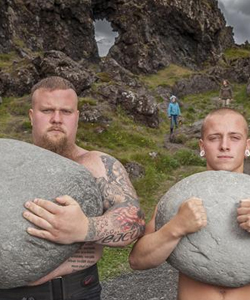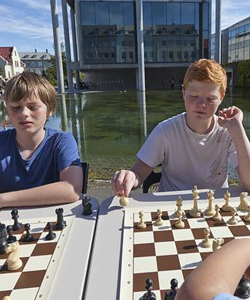
History & Culture
How it all began
Iceland is not only geologically one of the youngest countries on Earth. It is also one of the latest to be inhabited.
Iceland's first mentioning is dating back into ancient times, though. The Greek historian Piteas de Marsella wrote about "Ultimate Thule", a place he had heard tales about from travelling seamen. They described a land far up North, surrounded by a sea of floating icebergs, a land in which the sun during summer never sets.
We don't know for sure if this "Ultimate Thule" really is today's Iceland but the probability is high.

The Vikings and the first settlements
Ages passed before the official "discovery" of the island and the arrival of the first settlers. The exact point of time is yet unknown, as well who the very first settlers were. In fact Roman coins from the 3rd century have been found in Iceland, though it is uncertain if those coins came to the country that early or if they have been imported later by the Vikings who used Roman coins as a trading currency.
The Vikings were a Scandinavian people that lived in the territory of today's Norway, Sweden and Denmark. The majority of the Vikings were simple farmers, their main occupation raising cattle.

The fame the Vikings gained themselves in ancient times (and which has preserved itself until today) is that of grim warriors terrorizing the coastal regions of medieval Europe in search for gold and fame.
True, the Vikings went on raids. The raiding of the monastery of Lindisfarne in the former kingdom of North Thumbria marked the first one of a whole series mostly in England, Ireland and the North of France. After some time the Vikings didn't even have to throw themselves into battle. They were paid off in advance by the scared local kings.
Far less known is that the Vikings also set off East into Russia and came as far South as Byzantium (later: Konstantinopel), which is now the Turkish capital Istanbul. Their low keel boats allowed them to also navigate rivers.
The motivation for those journeys wasn't plundering but mere curiosity and the search for (legally earned!) riches and fame, or simply trade. Northmen (as the Vikings were often called) worked as mercenary soldiers in the Arabian kingdoms, the sons of chieftains were sent to foreign courts to learn and gain experience.
Beside archaeological findings an important source of knowledge about those ancient times are the so called "Landnámabók", the "book of settlement", and the "Islendigabók", the "book of the Icelanders". They were among the first historical books ever written, created by Icelanders with the idea of preserving the word-of-mouth tales of their fellow men.
From those books we learn that the Vikings arrived to Iceland by chance. In the middle of the 9th century the Northmen Naddoddr on his way to the Faroe Islands was led off course by a storm and landed on Iceland's East cost. He gave the newly discovered land the speaking name "Snæland": snow land.
Naddoddr didn't settle on the island, though, but continued his voyage on to the Faroe Islands.
Back home Naddoddr's tales inspired a compatriot, Flóki Vilgerðarson, to venture off in "Snæland's" direction. Passing the Faroe and Shetland Islands on his way he took three ravens on board his ship which earned him the nickname of "Raven Flóki" (Hrafna-Flóki).
Carrying ravens on ships was a common mean of navigation at those times. If, still on open sea, there was reason to believe that land, although yet unseen, was close the ravens were released. If the ravens didn't return it meant: land.
Raven-Floki's time on the island wasn't a long one. In the first winter all his animals died. In search for new, more hospitable land he one day went up a mountain. When he reached the top the only thing he saw was a fjord full of ice. Frustrated he changed the island's name to Iceland (Island). And went sullenly back to Norway.
According to the Íslendingabók and the Landnámabók the first person permanently settling in (now called) Iceland was the Norwegian Ingólfur Arnarson. He arrived in the year 874 AC to the place where Reykjavik is today. Reykjavik, by the way, means "steaming bay", the name deriving from the steam that rises widely visible from the hot springs in the area.
Arnarson's settling attempts were more successful than those of his predecessors. It didn't take long until more people followed, starting a continuous stream of immigration to the island that lasted 60 years and is known as the time of the "Landnám" - the settlement age.
Most of the first settlers arrived from Norway but there were also immigrants from Scotland, Ireland, the North of England and also from the Shetland, the Orkney and the Faroe Islands. Most of them were farmers who brought their animals (sheep and horses) along. They were the ones logging the sparse trees that grew in Iceland back in those times, using them for (ship) building and as firewood (read more in "Fauna & Flora" [internal link]).
Living conditions in Iceland at that time were good, even better than in Norway were most of the fertile land was occupied. In 930 the last parts of the island were colonized. About 60.000 people were living in Iceland by then - a number almost unchanged until the onset of the 19th century.

The Alþingi – the first democratic parliament

With time the Icelanders, most of all the ones born and raised on the island, began to view themselves as an independent nation. And felt the need for their own government.
Until now the settlers had organized themselves in the way they were used to back in their Scandinavian home countries. The lived in clans with one chieftain, called goði, who was the political and spiritual leader, being responsible for the offerings to the gods. When the need for more structure became apparent instead of opting for a one-man-power model - as it was common in the rest of Europe - the chieftains decided for a parliamentary assembly and created the Alþingi.
The Alþingi was held every year for two weeks at Þingvellir, in the South-East of the island. New laws were established, conflicts were solved and judgement was held. There were no written laws. All laws had to be remembered by the Lögsögumaður, the "man who tells the laws".
The Alþingi is the most ancient democratic parliament still in place, Thingvellir one of the most popular tourist sites, a part of the attractions on the Golden Circle.
The Icelandic sagas
The first century of the new republic was also its most prosperous. The nation was unified, natural resources abundant. The farms strived. This was the age of the spring of the famous Icelandic sagas, tales of heroes, love and war, of elves and trolls. The stories past by word of mouth. It wasn't until hundreds of years later that the sagas were first written down.

The dawn of Christianity
When the first settlers arrived they - apart from animals - brought with them their (pagan) religion.
The Vikings believed in gods like Odín, Thor, Freyr or Freyja and a world of glory and endless feasts for the brave warriors that died in battle.
At the beginning of the 11th century, though, almost the entire European mainland had converted to Christianity. This included the Danish-Norwegian kingdom under who's rule Iceland was. As political pressure became stronger Iceland was forced to take sides. The matter was brought to the Alþingi were after long discussions a (very witty!) "Salomonian decision" was taken: officially the country converted to Christianity, at home everybody could continue doing whatever he felt like.
Like on the mainland the new religion and pagan worshipping continued side by side for a long time before Christianity finally won over.

Eric the Red and the settlement of Greenland
Towards the end of the 10th century Eiríkur Þorvaldsson, better known as Eric the Red, was found guilty of murder of his neighbour and banned from Iceland for three years. Funny enough, a couple of years earlier his father had been banned from Norway for exactly the same crime. Eric had it in his genes, so to speak.
Not having anything better to do Eric took some friends and a boat and headed West. Similar to the story of the first sighting of Iceland also Eric had heard tales of new land by seaman who had been brought off course by a storm. And indeed: he made it to Greenland.
Three years he and his men explored the at that time unsettled south and west coast. Eric baptised the new land Grænland - Green Land, which seems strange looked upon from today's perspective. Not from Eric's, though. By the time Eric landed in Greenland at the end of the 10th century the climate was notably warmer than it is today. Furthermore, the sheltered fjords of the South and West had their own special climate, ideal for farming. Greenland was green.
But then Eric also chose the name „Greenland“ for publicity reasons.
After the end of his exile Eric went back to Iceland and convinced many of his compatriots to follow him back to this „green“ land, to build a new existence. To understand his success it is important to know that by Eric's time the best lands in Iceland were taken. This posed a problem not only for newly arriving immigrants from Scandinavia but also for the grown up children of the current settlers. Besides, the Icelandic lands were beginning to suffer from overgrazing, the soil loosing quality.
Greenland... Yes, that sounded good.
Of the 24 ships that headed East, though, half drowned during the dangerous journey across the open Atlantic Ocean. But the survivors established themselves well. Soon more immigrants followed. The colony strived. For 500 years. And then it vanished.
Why the Vikings disappeared from Greenland after 500 years of successful settlement is not fully clear. Recent research suggests that the reason was a combination of factors with the onset of the "Little Ice Age" and a notable drop of temperatures as being the most important one.

Leif Ericsson and the discovery of America
Leif Ericsson, son of Eric the Red, followed neatly into the footsteps of his father. He didn't murder anybody but it was him who, 500 years before Christopher Columbus, set foot on the American continent. He gave the new land the name "Vinland" - wine country.
Archaeological research proved that there was indeed at least one stable Norse settlement in the (today Canadian) Anse-Aux-Meadows. It was abandoned after only a few years, though, probably due to persistent conflicts with native (Indian) people.
The Middle Age
In 1263 Iceland fell under the governance of the Norwegian-Danish kingdom, receiving the status of a colony. The following years were one of the most sinister in Iceland's history.
At the beginning of the 15th century the pest reduced the Icelandic population by half. While Norway left the Danish Kingdom in 1814 Iceland stayed under Danish regime. Not only were the people struck by more epidemic diseases along with volcano eruptions, crop failure (and thus hunger) the repressive Danish colonial politic aggravated the country's misery notably.

On the way to independence
1918 the Icelandic people decided in a referendum to create an autonomous republic under the protection of the Danish crown. Half a century passed, though, before in 1944 Iceland gained complete independence. Sveinn Björnsson was the first democratically elected president of the new born republic of Iceland.
One year later Iceland became a member of the NATO and the European Council. Iceland stayed militarily neutral during the Second World War. But in 1951 the Alþingi granted the United States the deployment of American troops on Icelandic territory together with the permission to use the (military) airport of Keflavik - which the Americans had actually built themselves during the war. American troops continued to be based in Iceland until 2006.

Modern politics
As early as 1915 the equality of men and women became an integral part of the Icelandic constitution. It granted women the right to vote and the active participation in politics. In June 1080 Vigdís Finnbogadottir was elected president. Iceland became the first European country with a female head of state.
If Iceland should become a member of the European Union (EU) has always been a topic of fierce discussion in and outside of the parliament (the latter meaning in the case of Iceland: in the hot pots). The EU is (still) viewed by many with scepticism mostly for fear for the exclusiveness of their fishing grounds. Understandable, given the fact that the fishing industry is Iceland's main source of income.
In 2008 the famous banking breakdown threw the thriving country into an economic (and also psychological) crises from which it hasn't fully recovered yet.
It was only after the banking crash in 2009 that the newly elected government officially applied for accession into the EU. Negotiations, though, went slow and were overshadowed by unsolved economical topics in the aftermaths of the banking crash. With the governmental change in 2013 (back to the old pre-crash government...) the idea of becoming an EU member was frozen all together.

Economy
Agriculture and fishery are the two traditionally dominating industries in Iceland, although tourism is on the rise, likely to overtake fishery for the first time in 2014.
During the Danish monopoly in the 17th century trade was entirely in the hands of a few Danish trade companies. Vital goods were sold to the Icelanders at exaggerated prices and in often very low quality. As late as in the middle of the 18th century Icelandic companies were officially allowed to take part in the economic game. Iceland stayed one of the poorest countries in Europe until way into the 20th century .
From the moment it reached independence Iceland managed to lift itself up from the post-colonial muds and climb up into Europe's economic top in only a few years time, with a universal health care system and an education system free of charge.
Then came 2008.
The simultaneous collapse of the three most important national banks lead Iceland into the greatest economic crises since its creation. Because of the enormous size of the accumulated depth the banks were turned into national property. The Icelandic National Bank (Landsbanki) continues to do so until today (2013).
To get out of the situation the bankrupt country was forced to borrow money from befriended states and the International Monetary Fund. Inflation exploded. The exchange rate for the Icelandic Króna rose from 70 ISK to 250 ISK for one Euro.
But the inflation also had its advantages: it stimulated export. The new government used this to the country's advantage. With a set of other unconventional measures, concentrating on the stabilisation of national (un)employment, it succeeded to navigate the damaged Icelandic ship back into saver economic waters in very short time.
The Icelanders at that time gained themselves fame as „capitalist rebels“ when first the government and later the whole Icelandic republic in a referendum „decided“ to not pay back the depths the Landsbanki (or rather a branch of it called Icesave) had left.
Iceland's economic situation now is somewhat stable although he question of the refund of the depths hasn't been solved yet.